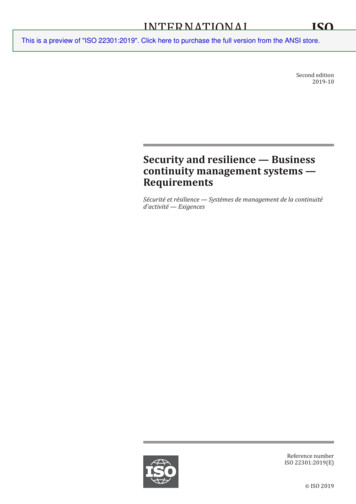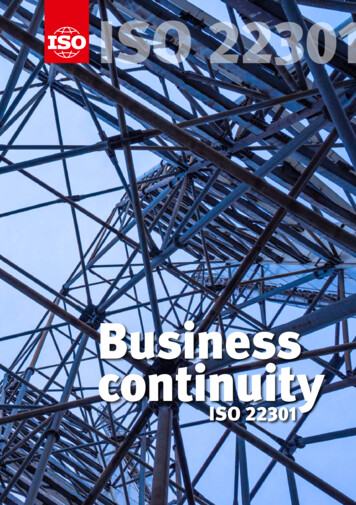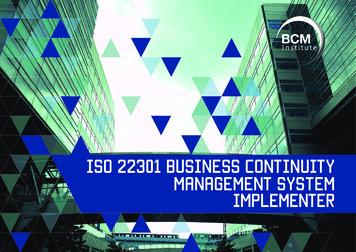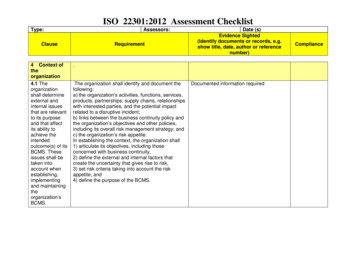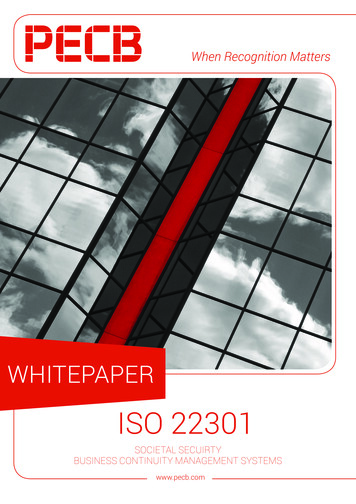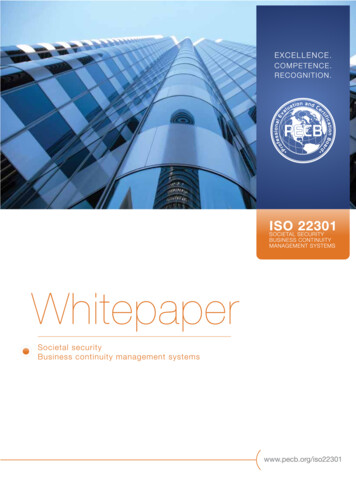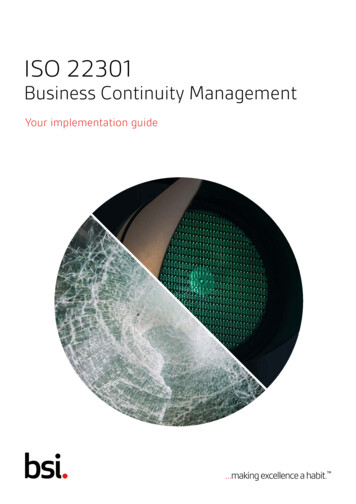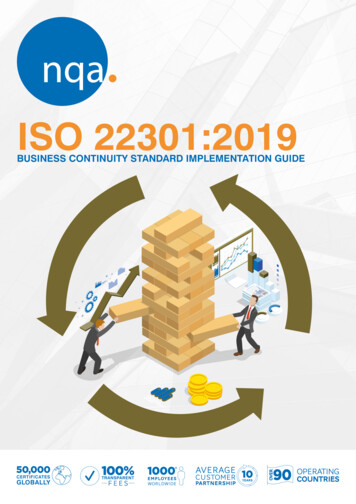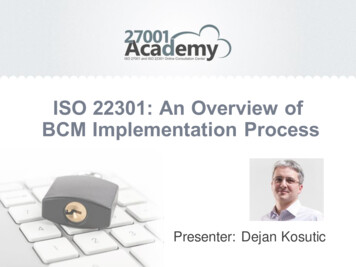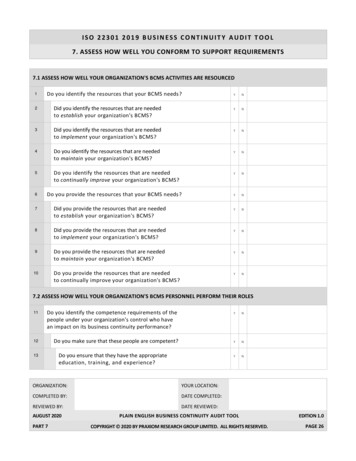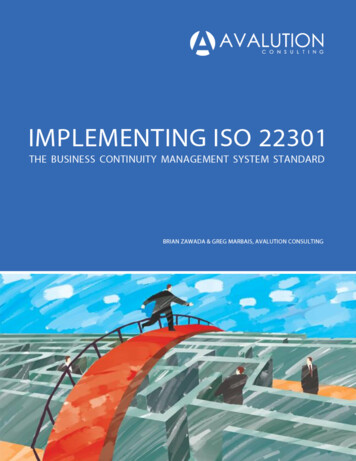
Transcription
i
IMPLEMENTING ISO 22301: THE BUSINESS CONTINUITY MANAGEMENT SYSTEM STANDARDThe business continuity community has been anticipating the release of ISO22301 (Societal security – Business continuity management system –Requirements) for years as a unifying standard that crosses internationalborders. Using simple, straightforward language, ISO 22301 summarizesminimum requirements for effective business continuity and can enablecoordinated preparedness among diverse organizations around the world.Overall, ISO 22301 offers a unique value proposition that will drive higher levelsof business continuity performance in years to come.BEFORE YOU BEGIN READINGOrganizations with a strong understanding of management systems realize the most value from ISO 22301,but we recognize that not everyone is familiar with management systems and their related processes. Assuch, this white paper is organized into three sections:SECTION 1: INTRODUCTION TO ISO 22301This section provides an overview of the standard, including its scope, audience, and valueproposition.SECTION 2: WHAT IS A MANAGEMENT SYSTEM?This section introduces key management system concepts that all business continuityprofessionals should understand before moving forward with the implementation of ISO22301.SECTION 3: UNDERSTANDING ISO 22301’S STRUCTURE AND CONTENTThis section focuses solely on ISO 22301, introducing practical, pragmatic guidance tosuccessfully implement the standard and take advantage of each element of the businesscontinuity management system.Throughout this white paper, we’ve included a number of links to related content published by ourconsultants. Consider clicking on these links for more in-depth information on these subjects. 2013 AVALUTION CONSULTING, LLC ALL RIGHTS RESERVEDii
IMPLEMENTING ISO 22301: THE BUSINESS CONTINUITY MANAGEMENT SYSTEM STANDARDCONTENTSSection 1: Introduction to ISO 22301 . 4Scope of the Standard .4Audience .5ISO 22301’s Value Proposition .5ISO 22301 at a Glance .7Section 2: What is a Management System? . 8Why Should Continuity Professionals Care About Management Systems? .8Key Characteristics of Management Systems .8Key Components of Management Systems .9The Relationship of Management Systems to PDCA .10How Do Management Systems Apply to Business Continuity? .11Relationship Between a Business Continuity Program and a Business Continuity Management System .12Where Can I Get Additional Information on Management Systems? .12Section 3: Understanding ISO 22301’s Structure and Content . 13ISO 22301 – The Introduction and the First Three Clauses .14ISO 22301 – Clause 4 – Context of the Organization .15ISO 22301 – Clause 5 – Leadership.17ISO 22301 – Clause 6 – Planning .19ISO 22301 – Clause 7 – Support .21ISO 22301 – Clause 8 – Operation .248.2 – The Business Impact Analysis and Risk Assessment .248.3 – Business Continuity Strategy .268.4 – Business Continuity Procedures .288.5 – Exercising and Testing .29ISO 22301 – Clause 9 – Performance Evaluation .32ISO 22301 – Clause 10 – Improvement .34Conclusions. 35Next Steps . 35About Avalution . 36For additional business continuity and IT disaster recovery-relatedresources, check out Avalution’s blog: perspectives.avalution.com 2013 AVALUTION CONSULTING, LLC ALL RIGHTS RESERVEDiii
IMPLEMENTING ISO 22301: THE BUSINESS CONTINUITY MANAGEMENT SYSTEM STANDARDSCOPE OF THE STANDARDAs stated in ISO 22301 Clause 1, the intended purpose of the standard is to enable organizations to “protectagainst, reduce the likelihood of occurrence, prepare for, respond to, and recover from disruptive incidentswhen they arise” by establishing, operating, and continuously improving a business continuity managementsystem (BCMS).The official title of ISO 22301 reflects that it is a “requirements” document, but what exactly does that mean?Essentially, standards are structured in one of two ways: REQUIREMENTS STANDARDS: A document written in a way that captures core elements of adiscipline that should be implemented regardless of an organization’s size, location or purpose(industry). In other words, requirements standards detail “what” an organization should do, notnecessarily “how” they should do it. Written using the word “shall,” requirements standards enableindependent audit and certification (if a business case warrants such a decision). GUIDANCE STANDARDS: Designed to complement a requirements standard or act in a purelyindependent manner, guidance standards detail more of the “how” by introducing implementationstrategy options based on best practices. In the case of business continuity, ISO 22313 is theguidance standard that supports ISO 22301 by offering implementation and continual improvementstrategies.Again, ISO 22301 is a requirements standard, written to enable auditability, as well as organizationalcertification for entities seeking such third-party, independent attestation. Certification, while optional, is avalue-adding differentiator for many organizations, particularly those engaged in business-to-businesstransactions, as it provides third-party validation of the effectiveness of the organization’s business continuitymanagement system. However, first and foremost, ISO 22301 was written to enable higher levels of businesscontinuity performance, and Avalution expects that the vast majority of organizations will align to the spiritand intent of the standard for that reason.The business continuity community has some fairly high expectations for ISO 22301. Avalution believes thatthe actual reaction will be mixed because some expectations often fail to align with the intent behind ISOauthored standards, in particular “requirements” standards. Already, many business continuity professionalsfeel the content in ISO 22301 is too high-level; many are looking for standards that address all possible needsfor all organizations. ISO standards follow a rigorous, consensus-driven process that leads to contentapplicable to all organizations – regardless of geography, size, structure, or purpose, including not-for-profitentities and those in the public and private sectors. As such, ISO 22301 is written in a manner that introducestopics so the wording is applicable to everyone. In other words, the content is high-level and describes thewhat, not the how. 2013 AVALUTION CONSULTING, LLC ALL RIGHTS RESERVED4
IMPLEMENTING ISO 22301: THE BUSINESS CONTINUITY MANAGEMENT SYSTEM STANDARDAUDIENCEISO 22301 describes business continuity planning concepts using clear, straightforward language that can beused by anyone in any organization to plan for, implement, and continually improve a business continuitymanagement system. Regardless of experience or job title, ISO 22301 enables those charged with leadingthe business continuity planning effort to understand business continuity concepts with significantly lessjargon and using descriptions in lieu of acronyms.Ultimately, any entity and personnel (including business continuity professionals, program sponsors andexecutive management) charged with preparing for disruptive incidents will benefit from ISO 22301 if theyintend to: Improve performance as it pertains to preparedness for a disruptive incident;Use approaches consistent with those employed by business partners and customers;Prepare for certification to the standard, if a business case exists (optional).To be clear, this standard is not just for those brand new to the businesscontinuity profession, nor is it strictly for the most experienced professionals.This standard is written for everyone with a role in mitigating risk associatedwith disruptive incidents.ISO 22301’S VALUE PROPOSITIONStandards exist to improve organizational performance in a specific discipline. As an extension ofperformance improvement, standards are designed to offer approaches and solutions to address the mostcommon challenges facing an organization. ISO 22301 is no different.As the first international standard focused exclusively on business continuity planning, ISO 22301 offerscontent to address the most common challenges facing the organization as a whole, as well as its businesscontinuity professional(s) and executive sponsors. In addition, the standard provides a framework to buildthe capability necessary to respond to, recover from, and operate effectively during the most challenging andunexpected circumstances.Avalution identified seven key challenges that ISO 22301 is well-positioned to address:1. CLARITY REGARDING BUSINESS CONTINUITY OUTCOMES: To executive management, the businesscontinuity outcome is not recovery time and recovery point objectives, or even up-to-date plans.These are all necessary, but they are means to an end. Mitigating the risk of a disruptive incident andensuring processes and resources are recoverable in order to meet interested party expectationsspecific to product/service delivery is not only the outcome executive sponsors expect, but whatthey want measured.2. FOCUS AND STRATEGIC ALIGNMENT: The standard focuses on an organization’s most importantproducts and services, which forces scoping using the same methods the organization uses tomeasure and improve organizational performance in general. This approach helps executivesconnect risk and impact to organizational initiatives, objectives, and obligations. 2013 AVALUTION CONSULTING, LLC ALL RIGHTS RESERVED5
IMPLEMENTING ISO 22301: THE BUSINESS CONTINUITY MANAGEMENT SYSTEM STANDARD3. MANAGEMENT ENGAGEMENT: Using management system concepts mapped to the Plan-Do-CheckAct (PDCA) model, this standard appropriately engages management and positions senior leadershipto participate in the process of strategically scoping and setting objectives, making strategicresourcing decisions, and prioritizing continual improvement opportunities based on performancecompared to objectives and needs.4. PERCEIVED COMPLEXITY: Unfortunately, businesscontinuity can often be perceived by many asoverly complex and burdensome. ISO 22301 waswritten to focus on the most important methodsto connect (and stay connected) with managementand perform the activities that lead to higherlevels of business continuity performance. In mostcases, the standard avoids the use of unnecessaryactions and acronyms. This approach contributesto diminished participant intimidation.If done correctly,organizations will assess riskin terms of an inability torecover the activities andresources that deliver theorganization’s mostimportant products andservices, which is a powerfulpresentation for anexecutive managementaudience.5. INTEGRATION: A growing number of organizationsare integrating business continuity with other riskmanagement disciplines, which demonstrates thatthe industry is maturing and becoming moreaccepted by executive management. As amanagement systems standard, ISO 22301 canhelp organization
IMPLEMENTING ISO 22301: THE BUSINESS CONTINUITY MANAGEMENT SYSTEM STANDARD The business continuity community has been anticipating the release of ISO 22301 (Societal security – Business continuity management system – Requirements) for years as a unifying standard that crosses international borders. Using simple, straightforward language, ISO 22301 summarizes

